Price reductions at Crocus
by Sarah - October 20th, 2010.Filed under: Crocus, Price Reductions.
Reduced price on items today at Crocus

anemone was £1.49 now £0.99
Position: full sunSoil: light, sandy soilRate of growth: averageFlowering period: March to AprilFlower colour: red, blue-violet and whiteOther features: contact with the sap may cause skin irritation; useful as cut flowersHardiness: fully hardyShallow bowl-shaped flowers in shades of red, blue-violet and white appear from March to April above the deeply divided, fresh green leaves. These pretty poppy-flowered anemones make charming cut flowers. They are ideal for a sheltered, sunny site.Garden care: Plant pre-soaked tubers 5-8cm (2-3in) deep in September or October in light, sandy soil in a sunny, protected site. Cover with a cloche or dry mulch to protect against extreme winter weather.
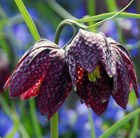
snake’s head fritillary was £2.49 now £1.24
Position: full sun or partial shadeSoil: humus-rich, moisture-retentive soilRate of growth: averageFlowering period: April and MayFlower colour: purple and whiteOther features: narrow, grey-green leavesHardiness: fully hardyBulb size: 6Pretty, pendent, white and pinkish-purple bells with distinctive checkerboard markings on slender stems in April and May. These delightful snake’s head fritillaries are perfect for naturalising in a moist woodland edge or wildflower garden. It’s essential to select a site where the soil remains moist in summer.Garden care: Plant 12cm (5in) deep from September to November in fertile, well-drained soil, taking care not to damage the fragile bulbs.
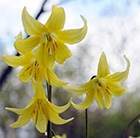
dog’s tooth violet was £3.49 now £1.69
Position: partial to shadeSoil: fertile, humus-rich, freely draining soil that does not dry outRate of growth: fastFlowering period: March and April Flower colour: yellow Hardiness: fully hardyBulb size: 12/31Each stem of this plant will carry up to 10 nodding, sulphur-yellow flowers with a brown central ring and deep yellow anthers. The foliage can be equally showy as it has either bronze-mottled, or fainter white marbling on the deep green, glossy leaves. In early spring this combination makes a very colourful display in woodlands and meadows. This is a vigorous plant which will form clumps and spread.Garden care: Plant bulbs 15 – 20cm deep and 15cm apart in naturalistic drifts where they can be left undisturbed for several years. Try to avoid planting under shrubs or trees that will soak up all the soil moisture in the summer.
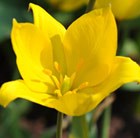
wild tulip was £3.99 now £1.99
Position: full sun or light dappled shadeSoil: fertile, well-drained soilRate of growth: averageFlowering period: April – MayFlower colour: yellowHardiness: fully hardyBulb size: 12+Dainty and deliciously scented, this tulip is ideal for naturalising in short grass. It is quite a vigorous plant, which can spread by underground stolons. First recorded in Bologna, in northern Italy in the 16th century, this delightful plant has now become naturalised throughout Europe where it can be found in meadows, orchards and open, rocky ground. It will thrive in full sun or light dappled shade and is quite tolerant of chalky soils.Garden care: In September to December plant bulbs 15-20cm deep and 10-15cm apart in fertile, well-drained soil. Alternatively, allow 7-9 bulbs per 30cm sq. After flowering dead-head and apply a balanced liquid fertiliser each week for the first month.

parrot tulip was £3.99 now £1.99
Position: full sunSoil: fertile, well-drained soilRate of growth: averageFlowering period: MayFlower colour: dark maroon-blackOther features: excellent cut-flowersHardiness: fully hardyBulb size: 1/12Dramatic, blackish-purple, cup-shaped flowers with irregularly cut wavy petals in May and strap-like, grey-green leaves. These spectacular black parrot tulips, one of the darkest varieties currently available, make excellent cut-flowers. To prevent the exotic flowers from flopping they’re best planted close together in a sunny, sheltered, well-drained spot.Garden care: In September to December plant bulbs 15-20cm deep and 10-15cm apart in fertile, well-drained soil. Alternatively, allow 7-9 bulbs per 30cm sq. After flowering dead-head and apply a balanced liquid fertiliser each week for the first month. Once the foliage has died down naturally lift the bulbs and store in a cool greenhouse.
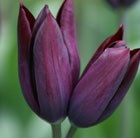
triumph tulip was £3.99 now £1.99
Position: full sunSoil: fertile, well-drained soilRate of growth: averageFlowering period: AprilFlower colour: deep blackcurrantOther features: excellent cut-flowersHardiness: fully hardyBulb size: 12+Deep blackcurrant coloured blooms with up to 3 flowers per stem appear in April. This has a similar colouring to the very popular Queen of Night tulip, but the flowers appear earlier on this variety. Therefore it is a great combination if you are looking to have an extended period of rich, deep colour in spring.Garden care: In September to December plant bulbs 15-20cm deep and 10-15cm apart in fertile, well-drained soil. Alternatively, allow 7-9 bulbs per 30cm sq. After flowering dead-head and apply a balanced liquid fertiliser each week for the first month. Once the foliage has died down naturally lift the bulbs and store in a cool greenhouse.

triumph tulip was £3.99 now £1.99
Position: full sunSoil: fertile, well-drained soilRate of growth: averageFlowering period: MayFlower colour: rich red with an cream trimOther features: excellent cut-flowersHardiness: fully hardyBulb size: 1/12 A beautifully coloured, classically shaped flower with dark red petals with rich orange edge fading to cream. So elegant, the flowers form the perfect tulip shape above tall, slender stems. Mix with oranges, yellows and other reds to create a hot spot in the garden.Garden care: In September to December plant bulbs 15-20cm deep and 10-15cm apart in fertile, well-drained soil. Alternatively, allow 7-9 bulbs per 30cm sq. After flowering dead-head and apply a balanced liquid fertiliser each week for the first month. Once the foliage has died down naturally lift the bulbs and store in a cool greenhouse.
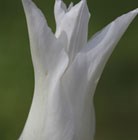
lily flowered tulip was £3.99 now £1.99
Position: full sunSoil: fertile, well-drained soilRate of growth: averageFlowering period: MayFlower colour: whiteHardiness: fully hardyBulb size: 12+Pointed petals flare out from a nipped-in waist, creating an elegant silhouette that will add interest to the bedding scheme when teamed with more traditionally shaped tulips. It associates particularly well with bicolour tulips like ‘Shirley’ or ‘Ballade’.Garden care: In September to December plant bulbs 15-20cm deep and 10-15cm apart in fertile, well-drained soil. Alternatively, allow 7-9 bulbs per 30cm sq. After flowering dead-head and apply a balanced liquid fertiliser each week for the first month. Once the foliage has died down naturally lift the bulbs and store in a cool greenhouse.
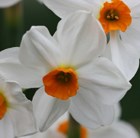
tazetta daffodil was £3.49 now £1.99
Position: full sun or partial shadeSoil: well-drained soil Rate of growth: fast-growing Flowering period: Mar-Apr Flower colour: white petals with an orange cupOther features: excellent cut-flowersHardiness: fully hardyBulb size: 1/12Richly scented flowers appear in clusters of up to six on top of sturdy stems in March and April. The pure white petals contrast brilliantly with the bright orange cup. Plant in groups where they can be left undisturbed and the clumps will get bigger each year. This is also a good variety for pots.Garden care: Wearing gloves plant bulbs 10-15cm deep and 10cm apart in autumn. After flowering feed with a balanced fertiliser, dead-head the flowers, but do not be tempted to cut back or tidy the foliage after flowering as this will interfere with the bulbs ability to store energy for the following years flowers.
cyclamineus daffodil was £2.99 now £1.99
white-flowered snake’s head fritillary was £4.49 now £2.24
fritillary was £5.99 now £2.49
American wake-robin was £4.99 now £2.49
viridiflora Tulip was £4.99 now £2.49
birthroot was £4.99 now £2.49
double late tulip was £4.99 now £2.49
parrot tulip was £4.99 now £2.49
jonquilla daffodil was £4.99 now £2.49
triumph tulip was £4.99 now £2.49






